Related Research Articles

Pseudevernia furfuracea, commonly known as tree moss, is a lichenized species of fungus that grows on the bark of firs and pines. The lichen is rather sensitive to air pollution, its presence usually indicating good air conditions in the growing place. The species has numerous human uses, including use in perfume, embalming and in medicine. Large amounts of tree moss is annually processed in France for the perfume industry.

The Hygrophoraceae are a family of fungi in the order Agaricales. Originally conceived as containing white-spored, thick-gilled agarics, including Hygrophorus and Hygrocybe species, DNA evidence has extended the limits of the family, so it now contains not only agarics, but also basidiolichens and corticioid fungi. Species are thus diverse and are variously ectomycorrhizal, lichenized, associated with mosses, or saprotrophic. The family contains 34 genera and over 1000 species. None is of any great economic importance, though fruit bodies of some Hygrocybe and Hygrophorus species are considered edible and may be collected for sale in local markets.

Hygrophorus is a genus of agarics in the family Hygrophoraceae. Called "woodwaxes" in the UK or "waxy caps" in North America, basidiocarps are typically fleshy, often with slimy caps and lamellae that are broadly attached to decurrent. All species are ground-dwelling and ectomycorrhizal and are typically found in woodland. Around 100 species are recognized worldwide. Fruit bodies of several species are considered edible and are sometimes offered for sale in local markets.

Hygrocybe is a genus of agarics in the family Hygrophoraceae. Called waxcaps in English, basidiocarps are often brightly coloured and have dry to waxy caps, white spores, and smooth, ringless stems. In Europe they are characteristic of old, unimproved grasslands which are a declining habitat, making many Hygrocybe species of conservation concern. Four of these waxcap-grassland species, Hygrocybe citrinovirens, H. punicea, H. spadicea, and H. splendidissima, are assessed as globally "vulnerable" on the IUCN Red List of Threatened Species. Elsewhere waxcaps are more typically found in woodlands. Most are ground-dwelling and all are believed to be biotrophs. Around 150 species are recognized worldwide. Fruit bodies of several Hygrocybe species are considered edible and are sometimes offered for sale in local markets.
Aeruginospora is a genus of fungi in the family Hygrophoraceae. It was formerly placed in the family Tricholomataceae, but it was moved to the Hygrophoraceae in a recent review of the family based on its morphological similarity to Chrysomphalina and especially Haasiella. It might be that Haasiella, which differs in spore color and ecology, is a junior synonym of Aeruginospora, but this has not yet been tested in a molecular phylogenetics study. The genus, described by Franz Xaver Rudolf von Höhnel in 1908, currently contains two species found in New Zealand and Indonesia. Six species formerly placed in Aeruginospora were transferred to the genus Camarophyllopsis. A. furfuracea might also belong in Camarophyllopsis, but it has not yet been restudied.
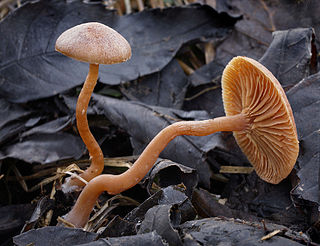
Tubaria is a genus of fungi in the family Tubariaceae. The genus is widely distributed, especially in temperate regions. Tubaria was originally named as a subgenus of Agaricus by Worthington George Smith in 1870. Claude Casimir Gillet promoted it to generic status in 1876. The mushrooms produced by species in this genus are small- to medium-sized with caps ranging in color from pale pinkish-brown to reddish-brown, and often with remnants of the partial veil adhering to the margin. Mushrooms fruit on rotting wood, or, less frequently, in the soil. There are no species in the genus that are recommended for consumption.
Aeruginospora singularis is a species of fungus in the family Hygrophoraceae. The species, described by Franz Xaver Rudolf von Höhnel in 1908, is found in Indonesia. The type specimen of this species was found growing in soil under bamboo at the Bogor Botanical Gardens, and it has been found there twice since then.

Gliophorus is a genus of agaric fungi in the family Hygrophoraceae. Gliophorus species belong to a group known as waxcaps in English, sometimes also waxy caps in North America or waxgills in New Zealand. In Europe, Gliophorus species are typical of waxcap grasslands, a declining habitat due to changing agricultural practices. As a result, two species, Gliophorus europerplexus and Gliophorus reginae, are of global conservation concern and are listed as "vulnerable" on the IUCN Red List of Threatened Species.

Humidicutis mavis is a gilled fungus of the waxcap family. It is found in Australia, Borneo, and New Zealand where the translucent white fungi grows from the ground to a height of 80 mm and a width of 50 mm.

Hygrocybe procera is a colourful Hygrocybe (waxcap) fungus. First described as Hygrophorus procerus by Greta Stevenson in 1963, the species was transferred to Hygrocybe in 1971 by Egon Horak. It is only known with certainty from New Zealand.
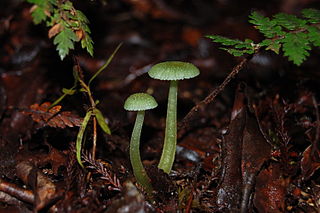
Gliophorus graminicolor is a species of agaric fungus in the family Hygrophoraceae. It is found in Australia and New Zealand. In 1995, Australian mycologists Tom May and Alec Wood transferred the species to Hygrocybe, but the taxonomic authority Index Fungorum retains it in Gliophorus.
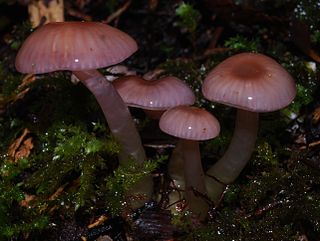
Gliophorus versicolor is a species of agaric fungus in the family Hygrophoraceae. Found in New Zealand, it was described as new to science in 1973 by mycologist Egon Horak. Within the genus Gliophorus, it is classified in the section Glutinosae, a grouping of species characterized by having bright colors, decurrent gills, and a gelatinized subhymenium. Fruit bodies have hemispherical to convex caps typically measuring 20 mm (0.8 in), although some have been recorded up to 50 mm (2.0 in). Moist caps are gluey with a color ranging from reddish brown to pinkish-lilac; the cap margin has radial grooves mirroring the gills underneath. The gills have an adnate to somewhat decurrent attachment to the stipe. They are widely spaced with color similar to the cap, or whitish. The cylindrical, hollow stipe measures 2–7 cm (0.8–2.8 in) by 1.5–3 mm (0.06–0.12 in) thick. The fungus is saprobic, and fruits on the ground among Dacrycarpus and Nothofagus.

Gliophorus lilacipes is a species of agaric fungus in the family Hygrophoraceae. Found in New Zealand, it was described by Egon Horak in 1973.
Egon Horak is an Austrian mycologist who has described more than 1000 species of fungi, including many from the Southern Hemisphere, particularly New Zealand and South America. He was an executive editor of the scientific journal Sydowia from 1975 to 1989, and a member of the editorial board afterwards.
Gliophorus bichromus is a species of agaric fungus in the family Hygrophoraceae. Found in New Zealand, it was described by mycologist Egon Horak in 1973.
Gliophorus pallidus is a species of agaric fungus in the family Hygrophoraceae. Found in New Zealand, it was described as new to science in 1973.

Gliophorus viridis is a species of agaric fungus in the family Hygrophoraceae found in New Zealand and Australia.
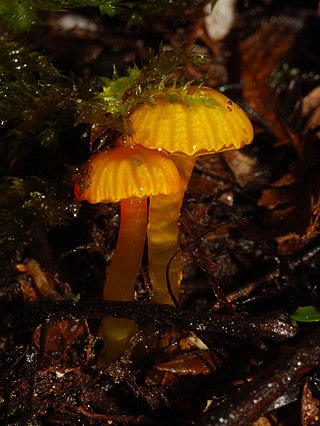
Gliophorus viscaurantius is a species of agaric fungus in the family Hygrophoraceae found in New Zealand.
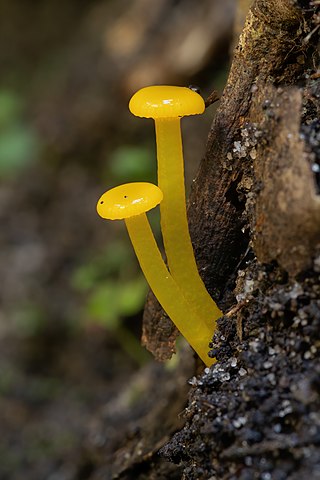
Gliophorus chromolimoneus is a species of agaric fungus in the family Hygrophoraceae found in New Zealand and Australia.
References
- ↑ "Aeruginospora furfuracea E. Horak 1973". MycoBank. International Mycological Association. Retrieved 2010-12-07.
- ↑ Horak, E. (1973). "Fungi agaricini Novaezelandiae I-V". Beihefte zur Nova Hedwigia. 43: 1–200 (see p. 125).
- ↑ Lodge DJ, Padamsee M, Matheny PB, Aime MC, Cantrell SA, Boertmann D, et al. (2014). "Molecular phylogeny, morphology, pigment chemistry and ecology in Hygrophoraceae (Agaricales)" (PDF). Fungal Diversity. 64 (1): 1–99. doi: 10.1007/s13225-013-0259-0 .